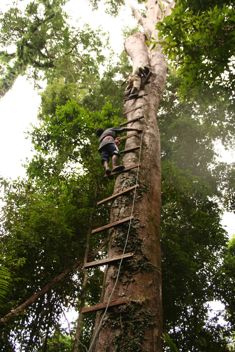Hornbills nest in cavities that develop naturally in old and dead trees. These birds are not capable of excavating them, maybe only in enlarging the entrance and the inside. However, such trees are never plentiful in a healthy forest. In urban areas dead trees are not tolerated as they pose a danger to life and limbs. Old trees with naturally developing large cavities are also deemed potentially dangerous. Due to this shortage in nesting cavities, there is always a fierce competition whenever there is one available.
On the offshore island of Pulau Ubin where most of our Oriental Pied Hornbills (Anthracoceros albirostris) are found, and there are about 20 birds or so, there seems to be no problem at the moment. With an increase in population, competition for nesting cavities will invariable develop.
Two pairs of these hornbill have moved to Changi on mainland Singapore. They have started breeding, although they have so far been unsuccessful in raising any chicks – see 1, 2, 3, 4, 5.
Limited number of these birds are also found inland (1, 2).
The Singapore Hornbill Project has been experimenting with nesting boxes at the Jurong Bird Park. Because these birds are caged, they are receptive to these boxes and are breeding inside. These boxes are now being tried in Pulau Ubin under natural conditions (top).
In Thailand, nesting cavities are excavated from pieces of tree trunks to specifications, hauled up along the trunk to be firmly attached to the tree (below left). These have proven successful. The image below (right) shows the Great Hornbill (Buceros bicronis) making use of such a contraption to breed.
Input by YC Wee; image of nesting box at Pulau Ubin by Angie Ng, those from Thailand courtesy of Prof Pilai Poonswad, Hornbill Research Foundation.












6 Responses
Awesome! I love seeing artificial nest sites being developed for rare species. I myself have been working on artificial nest sites for Stelgidopteryx swallows. They’re not by any standard threatened, but I think my artificial burrows will be applicable to rarer burrow-nesting species.
By the way, I’ve been following your blog for the last couple weeks, and I think it’s top-notch! Very enjoyable.
Cheers,
Nick
well done! but are these nest boxes save from poachers?
Any ”fine $10 000″ signs around to protect these birds?
I suppose we need signs in Singapore: no poaching, no this, no that, no everything… However, hornbill nests are safe in Pulau Ubin and artificial nests should also be safe, unless someone pinch it for a garden ornament. But you need to climb the tree…
In Thailand, most hornbill poachers have been bought over to help keep an eye on the birds, collect information and to build and set up artificial nests. So no problem at all.
Wow,
can anyone tell me exactly where are the nest boxes? I am thinking to go to ubin to take a look at the hornbills and their nest boxes.
JH
Birder123
Why don’t you just go to Ubin and ask at the NParks office?